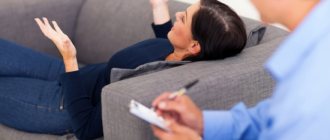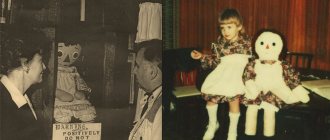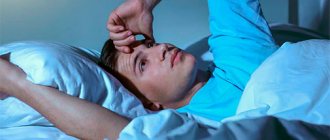Slava Profina 07/25/2018 no comments
1
Fear of any predatory, poisonous, large animal is quite normal. Fear in a person may arise due to the likelihood of meeting a frightening animal; the thought of it terrifies. Unfortunately, even small living creatures can cause hostility, such as toads. In psychology, the fear of frogs is called batrachophobia, which develops against the background of disgust or moral trauma.
Reasons for fear of frogs and toads
Reasons for the development of batrachophobia:
- Disgust and fear of infection. Few people find toads attractive, and they don’t smell very good, but for batrachophobes they look and smell especially disgusting: some types of frogs are poisonous, and some toads carry infection. However, most often this fear is associated with a lack of information about frogs. In fact, only tropical frogs are dangerous.
- Suggestibility. There is a myth that after contact with toads, warts appear on the human body. Many people believe this. And many parents intimidate their children with this.
- Psychotrauma received in childhood or adulthood. For example, a person has negative memories from eating frogs. Or the child was afraid of the animal when he first met it (frogs croak terribly and jump sharply). Or a person is mired in a swamp. Or in childhood, a child killed a frog, and then his conscience tormented him. Or he accidentally stumbled upon a dead frog or saw someone kill an animal.
In the case of psychotrauma, phobia acts as a defense mechanism. Fear and the avoidance reaction save a person from re-experiencing negative emotions and feelings.
Interesting! The Surinamese pipa (frog) lives in South America. She carries the frogs right in her back. In this case, the fear of frogs may be related to the fear of holes.
Ichthyophobia
This is the name given to the fear of fish, anything from aquarium fish to sharks, either live or as a ready-made dish. In a weak form, a person experiences only hostility towards them: these cold-blooded creatures are simply unpleasant to him to look at - disgusting scales, bulging eyes, and slippery to the touch, covered in some kind of mucus. But everything is much more serious if an individual experiences panic and unpleasant physical reactions when seeing a fish on a screen, a table, swimming in a pond, a pet store, or an aquarium. He has to avoid such places, depriving himself of many of the joys of life.
Ichthyophobia arises again in childhood. For example, dad brought a pike that was still alive from fishing, put it in the sink, and it fought so hard that it jumped out and scared the baby.
Another option: mother and daughter came to visit a friend who has an aquarium at home. While her friends were chatting and distracted from the child, the girl stuck her hand into the aquarium, trying to catch a beautiful fish. And that one, unfortunately, had sharp fins, and as a result: her hand was cut, blood was gushing, her daughter was crying in hysterics. The psyche is traumatized, and the child has developed a fear of fish, which can remain for life, unless, of course, treatment is attempted.
Signs and Symptoms of Fear of Frogs
Batrachophobe is frightened not only by the toads themselves, but also by everything connected with them: toys in the form of toads, the smell of a swamp, croaking, an image of an animal or a video about toads, including cartoons and films. A person tries with all his might to avoid meeting a frightening object. Batrachophobe changes the TV channel if he sees a toad there, and tries to run away if he hears the croaking of frogs.
If you can’t avoid the encounter (and sometimes even at the mere thought of frogs), somatic signs are added to the anxiety:
- nausea,
- vomit,
- sweating,
- headache,
- dizziness,
- tachycardia,
- arrhythmia,
- tremor,
- abdominal pain,
- chills,
- feeling of suffocation
- feeling of a lump in the throat,
- confusion,
- pressure surges;
- presyncope and fainting.
Some of the batrachophobes fall into a stupor. Others, on the contrary, become overly active and aggressive. During a panic attack, a person becomes dangerous to himself and others and does not control his reactions.
Important! Batrachophobe refuses to visit bodies of water or relax in forests and parks. In advanced stages, he is generally afraid to leave the house; he imagines the croaking of frogs or the smell of a swamp.
Symptoms of the disease
It is rare in the world to meet a person who has tender feelings and a special affection for frogs, but not everyone is called a batrachophobe because of this. It is quite easy to distinguish a person who has a phobia from an ordinary toad hater thanks to the following symptoms:
- Fear of visiting bodies of water where you might encounter an amphibian. Such a place will be regarded by a bufonophobe as an area of increased risk to life.
- Fear of any objects on which frogs are depicted (toys, kitchen items, books, magazines, photographs, etc.).
- Constant feeling of anxiety and danger when going outside.
- Changing channels when seeing a fear trigger on the TV screen.
- Constant feeling that everything around smells like a swamp and toads.
- Irritability when a frog croaks.
- Increased sweating at the sight of a live frog, the patient’s skin begins to turn pale, he begins to choke, clutch his heart, and lose consciousness.
- Nausea and vomiting in the place where the encounter with the object of fear occurred.
In any case, a person with a phobia begins to behave inappropriately: he gets nervous, stutters, and cannot connect words into sentences. In this case, you need to take the patient home, offer him to drink a sedative and visit a psychologist's office.
How to get rid of the fear of frogs and toads
Psychologists use the following methods to treat fear of frogs:
- art therapy, fairy tale therapy (an example of a therapeutic fairy tale for fear of frogs and toads) and other techniques that help to form a positive attitude towards and perception of toads (most often used to treat fear of frogs in children);
- a technique of gradual rapprochement with fear (the psychologist and the client make a list of frightening situations from the least scary to the most scary and gradually the person is immersed in it);
- hypnosis (indicated in cases where a person does not remember what triggered the phobia);
- auto-training (suitable for self-help in stressful situations).
In cases where a person does not control his behavior and is not ready for constructive interaction with a psychologist, taking medication is indicated. The specialist prescribes tranquilizers, sedatives, and antidepressants.
Important! You cannot start taking medications on your own, but you can use herbal sedatives.
Celebrities who suffer from bufonophobia
Famous personalities, whose lives are under constant control of the paparazzi, cannot hide their fears, so they willingly share them with journalists and fans. There are also batrachophobes among celebrities, including:
- Max Barskikh, who has been afraid of frogs since childhood. The fear was caused by an amphibian bite after the boy tried to pick up the toad. After this, Max cannot stand the sight of this animal; in Thailand, he even refused to try a delicacy made from frogs, although he willingly ate other local exotics (cockroaches, larvae, grasshoppers).
- Paul Marinassio, who became famous thanks to his construction company in America. He hates croaking. The man said that his plot is flooded and many frogs have settled on it, so he has to turn to his daughter for help, who helps him fight amphibians. Paul even managed to earn more than $1.5 million from his phobia - this is exactly the amount the neighbors paid the celebrity for the damage caused.
- Marina Tsvetaeva, who was afraid to pick up tailless amphibians and ran away from them in panic. This happened after the poetess brought a living creature to the face of her frightened friend - the girl’s screams amazed Marina Tsvetaeva so much that she threw out the frog and began to be afraid of them.
Obsessive phobias
Obsessive phobias (obsessive fears) - pronounced and difficult to overcome fears, despite the understanding of their meaninglessness and groundlessness, are encountered relatively often in clinical practice. Some authors recorded them in 87% of patients with obsessive disorders (Panov A.G., et al., 1973)
K. Leonhard (1959) believed that phobias often arise in people with a lively and even hypomanic temperament, which is a kind of defense against anancasm.
Among talented people, in particular writers and their close relatives, phobias are relatively common. Let's give a few examples.
The father of Nikolai Vasilyevich Gogol was suspicious, afraid of all kinds of diseases, according to G. Danilevsky, he was somewhat reminiscent of the character from “Dead Souls” - the landowner Manilov. N.V. Gogol wrote that his father did not die from any specific disease, but only “from the fear of death.”
In his youth, the writer did not like to attract the attention of strangers, however, after 40 years and a stay in Germany, he changed somewhat. Probably a mental disorder first clearly manifested itself in N.V. Gogol in the twenty-first year of his life, he had an obsession - to teach at the department of Kyiv University. Later, in 1836 in Paris, he became extremely suspicious, he could imagine that he had some serious illness, most of all he was afraid for his stomach, and there was no way to dissuade him. N.V. Gogol wrote in 1840 “... My treatment was quite dangerous: what could have helped the stomach had a destructive effect on the nerves, and the nerves had a destructive effect on the stomach, and this was accompanied by a painful melancholy that cannot be described. I was brought into such a state that I didn’t really know where to put myself, what to lean against.” Note that at this time the writer became very religious.
N.V. Gogol, speaking about the peculiarities of his work, stated: “I contained a collection of all possible nasty things, a little of each, and, moreover, in such a variety that I had never seen before in any person... I began to endow my heroes, in addition to their own nasty things, my own trash."
Anton Pavlovich Chekhov believed that he had a “fear of space,” a fear of the public and publicity. Some doctors believed that the writer was a psychasthenic all his life, expressing hypochondriacal complaints even before he fell ill with tuberculosis.
Dostoevsky was an extremely suspicious person; he preferred water to tea, was horrified by flower tea and worried about his pulse rate. Fearing lethargic sleep, he left warning notes at night (“Today I will fall into a lethargic sleep. Bury me no sooner than in five days.”), carefully monitored the condition of his tongue and listened to the slightest disturbances in the activity of his body.
He was hypochondriacal and experienced various fears. At a young age, he became interested in playing billiards to the point of losing big and meeting cheaters. This passion for gambling, especially for roulette, intensified after returning from hard labor.
The Danish storyteller G. H. Andersen was prone to melancholy throughout his life. He was constantly self-absorbed, unbalanced and restless, and with age he became more and more hypochondriacal and was troubled by obsessive fears. He was so afraid of dying from fire that when he traveled, he always took a rope with him, hoping to escape with it in case of fire. He, as well as N.V. Gogol was afraid that he would be buried alive, and asked his friends that in any case one of his arteries would be cut before he was placed in the coffin. When he was sick, he often left a note on the table by his bed: “It just seems like I’m dead.”
The English writer Charles Dickens was a pedantic person who hated the disorder and chaos that was so abundant in his childhood. According to people who knew him, his punctuality bordered on vice. After the accident in which he was involved in 1865, he began to experience sudden attacks of fear, even while riding in a gig - causeless, but nevertheless completely irresistible.
Analysis of many phobias often reveals their symbolism, substitutive nature, expression of one or another problem quite typical for the patient. Some psychoanalysts even believe that eliminating phobias can in some cases lead to increased aggression and the manifestation of other symptoms of a neurotic disorder
Patients usually realize the groundlessness and absurdity of their fears, but cannot overcome them. True, with a sharp increase in phobias or so-called “phobic raptus,” criticism of one’s condition may be partial.
The behavior of a patient suffering from phobias is structured in such a way as to eliminate as much as possible (avoid, avoid) the situation in which phobias appear.
From the point of view of cognitive psychology, patients are prone to distorted perception, erroneous assessment of signals, both from internal organs, for example, the cardiovascular system, and external stimuli associated with an imaginary danger. These stimuli (external and internal) provoke the appearance of thoughts and images of a catastrophic nature, which in turn subsequently trigger feelings of anxiety and fear. Increasing tension and increasing phobias lead to various disorders of the autonomic nervous system. In this case, patients feel that they are losing control not only over the situation in which they are currently located, but, what especially frightens them, they cannot control the activity of various organs and systems, primarily the cardiovascular (rapid pulse, rising blood pressure, pallor of the skin, coldness of the tips of the hands and feet) and respiratory (difficulty in inhaling, frequent and shallow breathing). The patient is forced to look for some behavior options that “save” him from an imaginary danger: leave the threatening situation as quickly as possible, take a tranquilizer, distract himself with conversation or work, etc.
Ultimately, patients reinforce a certain stereotype of the pathological chain (“vicious circle”): an imaginary dangerous situation - catastrophic thoughts and images - tension, anxiety, phobia - dysfunction of the autonomic nervous system - avoidant forms of behavior - attitude towards potential danger (period of increased anxiety, caused by the anticipation of a phobia), the situation and those stimuli that triggered the phobia. Let us note that it is the “catastrophic interpretation” that is the direct source of the phobia.
Of course, this diagram is extremely simplified; many links of this pathological chain intersect and themselves support the source of tension, for example, various autonomic disorders enhance catastrophic thinking, thereby maintaining a high level of tension and the intensity of phobias. Tachycardia frightens patients with possible cardiac arrest, high blood pressure with the risk of hypertensive crisis, dizziness with a stroke, and “blackouts” with the threat of fainting and falling.
Patients are especially frightened by the phobias that often accompany obsessive fears, feelings of derealization and depersonalization, probably caused by a short-term and, by and large, harmless circulatory disorder in the caudal part of the brain stem, provoked by dysfunction of the central parts of the autonomic nervous system.
In this case, patients mistakenly believe that the feeling of change in their own “I” or the surrounding reality are symptoms of a severe mental disorder, such as schizophrenia. Patients are afraid of going crazy, completely losing control over their actions, and looking ridiculous in the eyes of others.
It seems that before the onset of phobias, patients experience tension for a long time due to various psychological stressors (most often conflict with significant people). Patients may also be weakened by some kind of infectious (bacterial, viral infection) or intoxication (alcohol, marijuana, caffeine, etc.) process; prolonged relapse of a psychosomatic disorder (peptic ulcer, arthritis, etc.); intense physical and psychological stress.
As a result, it is as if the defense “breaks through” and is overcome by pathological factors, that “threshold of strength” of the body, after which various autonomic disorders and phobias easily appear.
C. Beck, Gardner W. (1985) in relation to panic disorder, distinguish predispositional and provoking factors. The former include heredity, certain physical disorders that trigger somatic symptoms resembling those of anxiety, traumatic experiences, ineffectiveness in stress management, and thinking within a pattern of helplessness. Triggering factors include physical illness, toxic substances, and environmental stress. However, these researchers do not consider “fear of death” to be an obligatory phenomenon of a panic attack.
In the genesis of obsessive fears and phobias, defensive reactions are also traced, having the character of not only “direct” but also “symbolic” defense - ritual actions (Gindikin V.Ya., 1997). Patients often develop complex and partly senseless ways of dealing with their fears, which, oddly enough, turn out to be very, but of course, temporarily effective. However, here we are talking about rituals, to which separate lines of this book are devoted.
The results of numerous studies indicate that certain brain structures are predominantly involved in the pathogenesis of phobias: the prefrontal cortex, amygdala, hippocampus, dorsal raphe nuclei and locus ceruleus. The following systems of neurotransmitters and neurohormones are involved: the hypothalamic-pituitary-adrenal axis, the noradrenergic and serotonergic systems. Various disturbances of other neurotransmitters also occur.
Phobias are heterogeneous, varied, and relate to various situations, most of which do not pose any danger.
Usually, the same patient has a fear of different objects and situations or a combination of phobias.
An exception may be mysophobia and ereutophobia (ereutophobia), which are relatively often observed in isolation.
Phobias may seem to be a consequence of obsessive thoughts, sometimes they accompany them, less often they are primary, and sometimes it seems that the obsession arose as if to explain the phobia.
Typically, phobias concern some kind of harm or danger to a person. In the same patient, there is often a transition of obsessive fears into their opposite. The fear of stealing something turns into the fear of being robbed, the fear of injuring someone with a sharp object turns into the fear of cutting yourself, love for a child turns into an obsessive fear of killing him, etc. These “strange transformations of fears into desires”, students of I.P. Pavlov was explained by a hypothesis based on the recognition of the presence of an “ultra paradoxical hypnotic phase” (Davidenkov S.N., 1963).
Some psychiatrists explained the emergence of some obsessive fears by the mechanism of self-hypnosis. “A patient, for example, is obsessed with the idea that he cannot cross an open place alone, and no reasonable arguments can dissuade him. He is aware of the validity of these arguments, but does not submit to them, because his self-hypnosis is too powerful. In general, our logical thinking is mostly powerless against autosuggestion” (Mol A., 1905).
From the point of view of N.D. Lakosina and A.V. Pavlichenko (2010) in the USSR, the study of neurotic phobias in the 60s-70s of the twentieth century revealed, along with the expansion of situations that cause fear, the addition at a certain stage of their dynamics of obsessive disorders, in particular contrasting obsessions and obsessive doubts, and this feature was turned out to be due to long-term use of traditional antipsychotics and sedative tranquilizers, which further aggravated the dissociation between affective and ideational structures existing in anxious individuals. These authors believe that if earlier an unfavorable variant of the dynamics of the phobic syndrome, characterized by the appearance of obsessive symptoms, was associated with the use of traditional antipsychotics, then in recent years the decompensation of the patients’ condition was caused by the rapid withdrawal of antidepressants and manifested itself in severe hysterical disorders.
Before a brief description of some obsessive phobias , we note that many psychiatrists, in our opinion, erroneously, generally excluded the latter from obsessive-compulsive disorder, believing that they were more characteristic of a personality disorder.
If some phobias are replaced by others, then in the end, the patient may develop phobophobia - fear of the phobias themselves.
Phobophobia is an extremely interesting psychopathological phenomenon that is often found in the structure of obsessive-compulsive disorder. As the latter progresses, the content of the original phobia gradually fades into the background and “pure fear” begins to dominate in the patient’s consciousness, as an obsessive state before the possibility of the first phobia arising.
Obsessive fears and phobias should be distinguished from “fear neurosis”, although at present the independent existence of “fear neurosis” is considered impossible. Previously, it was believed that the main symptom of “fear neurosis” is a feeling of pointless anxiety or “substandard fear”; it is the pointlessness of the phobia that distinguishes this condition from obsessive-compulsive disorder.
In the literature there are various classifications of phobias, for example, they are divided into diffuse (“fear neurosis”); communication (agoraphobia, social phobia, fear of injury and integration, dysmorphophobia); selective phobias - avoidance of conditions in which fear arises, focused fears - organ phobias; phobias in mental illness (Strian F., 1983).
A patient suffering from obsessive-compulsive disorder may experience persistent and intense fears due to obsessive thoughts regarding the danger of contamination , infection (English: fears of contamination), any infectious disease, for example, a viral or bacterial infection, poisoning with various poisons or toxins.
L. Pasteur, suffering from obsessive thoughts associated with the fear of contamination, contamination or infection, avoided shaking hands and wiped his glass and napkin before dinner, which may have been the source of his discoveries in the field of microbiology.
Pollution phobias are closely related to the phenomenon of "sympathetic magic" or implausible views (beliefs) about the nature of contagion (contamination). For some such views, the orthodox belief “any contact is always dangerous” is typical, even if contact with a potentially infected person is stopped, those objects that he touched are already considered infected. In other cases, any similarity or external resemblance to a possibly infected object already serves as an indisputable argument of the danger of infection.
Pollution (contamination) phobias are quite common among patients suffering from obsessive-compulsive disorder and, in particular, obsessive-compulsive disorder, usually accompanied by constant hand washing and other cleanliness rituals in order to free themselves from contamination. It has been noted that obsessive phobias of pollution are often observed in the presence of hysterical character traits in the premorbid, in people prone to hypochondria.
Among patients suffering from obsessive-compulsive disorder, pollution phobias are recorded in almost 55-58% of cases (Rasmussen S., Eisen J., 1998).
The affective state is accompanied by vegetative correlates of emotions: paleness of the face, coldness of the hands, cold sticky sweat, tachycardia, a feeling of “heart stopping or freezing,” rapid breathing with difficulty inhaling, less often exhaling.
Infection, from the point of view of such an extremely squeamish patient, is most likely through direct contact with an infectious patient, those objects that he touched, but it is also possible simply by staying in places where infected people or things could potentially be located (chairs, door handles etc.). Hence the need to avoid potentially those places where infection is possible (public toilets, hospitals, places near garbage containers, etc.).
With obsessive fears of infection, patients believe that they can become infected even with a single contact with any potential source of danger, and infection will occur even if the contact took place relatively long ago or through objects that once came into contact with “infectious things.”
Patients often control their every movement to eliminate the risk of infection.
In addition, infection, according to the patient, can occur through airborne droplets or some other method, even little known to science. Those suffering from obsessive-compulsive disorder may assume that infection will also occur due to contact with the secretions of infectious patients, for example, their saliva or sweat.
Sometimes patients believe that they themselves can become a carrier of germs and infect innocent people, so a nurse fears that along with the medicine she will inject one of the patients with the hepatitis or AIDS virus, a television master believes that he could cause the spread of a dangerous infection , which he contracted in one of the apartments. Over time, these thoughts begin to constantly swirl in your head, as if expanding their circle. And the nurse believes that she can infect others through her dirty hands, and the television master believes that she will bring infectious germs from the street. To get rid of these thoughts and fears, they begin to carefully monitor where they can become infected.
Some patients say that they can infect others with their “dirty thoughts”, that their “negative energy” is transmitted through words, images to other, close people, especially significant to them, and in order to save others it is necessary to perform certain rituals, for example, wash your hands, hold your breath, or exhale, perform other actions aimed at protecting loved ones, or imagine positive images that are opposite in meaning, replacing the negative pictures of “dirty and dangerous” ideas.
Patients with obsessive thoughts of infection, as well as other obsessive states, are prone to mysticism, esoteric, “magical thinking”, and are often carried away by Eastern teachings about meditation. According to P. Rosun, A. Fallon (1987), magical explanations should be considered an obligatory component of infection phobia. Frazer J. (1959), believed that magical thinking here finds confirmation and support in the characteristics of those things through which contamination is possible, even when contact with dangerous objects has already ceased (the first law of “sympathetic magic”). The second law of “sympathetic magic” suggests that infection can also occur through other, at least somewhat similar, things and objects.
In his book, translated in Russia in 1903, “Neuroses and Fixed Ideas,” P. Janet cites the clinical case of Justine, who could not touch fruits because they “through associations of ideas, brought cholera to her memory; the thought of it and even the very name of cholera, which Justine, despite her desire, was always afraid of, caused attacks of fear, excitement and even nervous attacks in her.”
Research suggests that pollution phobias can be triggered by images and ideas about dirt (Fairbrother N., et.al., 2005).
By and large, their beliefs are based more on faith than on logical reasoning. Moreover, detailed questioning reveals their “own theories of infection,” built on complex and rather intricate hypotheses.
It seems that patients, as it were, build on their theories to substantiate and explain absurd fears.
In a number of cases, fear of certain words (death, murder, suicide, etc.), symbols (cross, star, etc.), numbers (666, 13, etc.) and everything that is associated with these words or numbers is revealed. Patients are confident that if they encounter such a word, symbol or number, something bad will happen. Attempts are made to eliminate any collision with such words, symbols or numbers. One of our patients, a 13-year-old girl, was afraid of poultry, geese and chickens, and in every possible way avoided looking even at drawings depicting them; when she met them, she tried to protect herself from them using the word “Yaritsa” she invented, which was an abbreviation from the phrase “I’m not a chicken.”
Obsessive fears and phobias can also expand according to the consonance of the letters denoting phobias.
At one time N.M. Asatiani (1967) showed that the development of obsessive-compulsive neurosis is accompanied by a kind of stages of complication of obsessive phobias. At the first stage, fear arises only during the action of the corresponding stimulus; later, it appears only if there is a probability of encountering the stimulus; as the clinical picture of neurosis further becomes more complex, fear arises even with the appearance of just an idea of the stimulus.
Psychiatrists note that phobias partly reflect the characteristics of the historical period in which a person lives. For example, in recent years, phobias of various diseases, for example, cancer or cardiovascular disease, AIDS, have become more common.
The American Classification of Mental Disorders (DSM-IV) divides simple specific phobias into 5 classes: animal phobias, natural environmental phobias, blood/injection/injury phobias, situational phobias, and “other phobias.” Phobias are registered in a wide range in 4.5-11.9% of the population, the risk of developing phobias throughout life reaches 11.3%.
In men, simple specific phobias are much more common than in women (1: 3), but phobias to animals and situational phobias are recorded with equal frequency in both men and women. The most common period of manifestation of phobias is adolescence, usually 15 years, phobias towards animals can appear at the age of 7, claustrophobia - at the age of over 20 years.
In the etiology of simple phobias, both genetic and environmental factors play a role, including characteristics of upbringing. So, in particular, in monozygotic twins they are observed in 25.9% of cases, in dizygotic twins - in 11%.
Simple phobias are quite often accompanied by various symptoms of the anxiety spectrum, often combined with panic attacks and social phobias.
In addition, simple phobias sometimes arise and intensify during a depressive or manic episode. At the same time, alcoholism and drug abuse are observed much less frequently in simple phobias than in other anxiety spectrum disorders, such as panic attacks or agoraphobia.
In many cases, without treatment, simple phobias periodically increase in severity and this mental disorder takes a chronic course.
Some phobias are preferably combined with others. For example, cardio-, cancer-, syphilophobia, as a rule, coexist with noso- or thanatophobia; cardiophobia leads to the secondary occurrence of claustrophobia, and later agoraphobia; Lissophobia is accompanied by mysophobia and oxyphobia. This preference for the formation of secondary and tertiary phobias is revealed in the dynamics of the development of neurotic obsessive-phobic disorder. In turn, at the stage of the reverse development of the disease, there is primarily a weakening and reduction of tertiary, secondary, and later primary phobias (Ushakov G.K., 1987).
Sometimes obsessive fears arise in people of certain professions: pilots have a fear of flying on airplanes, actors have a fear of going on stage due to the fact that the text will be forgotten or inappropriate actions will be performed (Bekhterev V.M., 1915). S.N. Davidenkov (1963) cites obsessive fears typical of doctors: fear of autopsies due to the thought that the person being opened by the pathologist is still alive and only in a lethargic sleep; fear of an accidental mistake in a prescription. Attempts to overcome these conditions are accompanied by pronounced manifestations of the autonomic nervous system.
With a fear of heights (hypsophobia), patients, oh, she seems to be “calling”, it seems that the balcony may not hold up and collapse, the bridge will collapse, an absurd thought arises to jump down, “cross the line”, the fear of losing balance and falling. A person is struck by the meaninglessness of these thoughts and at the same time frightened by their danger. In some people whose profession involves working at heights or who have optical and vestibular disorders, a phobia of heights may arise after a traumatic situation, however, such conditions do not leave any serious consequences.
A.S. Chistovich (1946), reflecting on the genesis of height phobia, recalls the case of the dog John, whose M.K. Petrova (student and associate of I.P. Pavlov - author's note) managed to cause a completely unique disturbance of higher nervous activity with special tasks aimed at “tormenting the inhibitory process.” “We ourselves could see that this dog, having been brought onto the stairs” (in the “tower of silence”), although obviously hungry, tucked its tail and began to rapidly back away from pieces of meat lying at the edge of the flight of stairs (fenced, of course, by railings. Then the same meat, but placed on the stairs near the wall, far from the flight, she ate greedily. Regarding this dog (and then managed to cause phobias in other dogs) IP Pavlov said that in cases where a normal animal, having approached the edge of a pit or ladder, does not move further, this means that it detains itself, it experiences inhibition, but it arises in accordance with the need so as not to fall. In John, this delay manifested itself in an exaggerated, excessive way and stopped the dog far from the edge “over needs and to the detriment of the dog's interests. I.P. Pavlov believed that subjectively this is clearly a state of fear, fear. That is, this is a “phobia of depth.” I.P. Pavlov considered such an exaggerated pathological delay to be a manifestation of the lability of the inhibitory process " .
When a person is afraid of something, he tries to run away from danger, but this only makes the fear stronger. The above can be illustrated by the heroes of the American journalist Ambrose Bierce, whose work occurred in the second half of the 19th century. The hero of his work “The Man and the Snake” (1891), Brighton Harker, becomes a victim of his wild imagination: he dies of a heart attack, mistaking a stuffed animal under his own bed for a living snake. The more Brighton tries to convince himself of the absurdity of his fear, the more easily he succumbs to the snake’s “hypnosis.”
Common obsessive fears include aichmophobia - the fear of sharp objects, usually due to an exaggeration of the danger from damage that the latter can cause.
The patient may be afraid of sharp objects because they can cause harm not only to themselves, but also to others, and to do this in some simple or even sophisticated way. He tries to hide sharp objects: knives, forks, feathers, pencils, etc. Phobias
- Aviophobia - fear of flying by plane
- Agoraphobia - fear of squares, passages, open spaces
- Aichmophobia (oxyphobia) - fear of sharp objects
- Acarophobia - fear of contracting scabies
- Alienophobia - fear of going crazy
- Amaxophobia - fear of wheeled vehicles
- Anthropophobia - fear of people, crowds, communication with other people
- Anuporophobia - fear of signing
- Arachnophobia - fear of spiders
- Arithmophobia - fear of certain numbers
- Astrophobia - fear of lightning
- Atremia (stazo-basophobia) - fear that occurs when trying to move
- Autophobia (monophobia) - fear of loneliness
- Basophobia - fear of walking
- Bathophobia - fear of depth
- Vertigophobia - fear of fainting
- Vomitophobia - fear of vomiting in the presence of other people
- Heliophobia - fear of sunlight
- Helminthophobia - fear of becoming infected with worms
- Hematophobia - fear of bleeding
- Herpetophobia - fear of snakes
- Hydrophobia - fear of sweating and unpleasant odor
- Hypsophobia (acrophobia) - fear of heights, being on the balcony, on the roof, of climbing
- Dentophobia - fear of dental intervention
- Dysmorphophobia - fear of deformity, abnormal development of a certain part of the body, usually the face
- Cancerophobia - fear of cancer
- Cardiophobia - fear of death from cardiovascular disease
- Kenophobia - fear of empty rooms
- Claustrophobia - fear of enclosed spaces
- Kleptophobia - fear of stealing something or being robbed
- Lalophobia - fear of speaking in an audience
- Lyssophobia - fear of contracting rabies, obsessive fear of madness
- Mysophobia (ripsophobia) - fear of contamination or infection when touching objects, people or animals
- Mythophobia - fear of telling a lie, lying
- Monophobia - fear of loneliness
- Necrophobia - fear of the dead
- Nosophobia - fear of illness
- Onanophobia - fear of the consequences of masturbation
- Panphobia (pantophobia) - fear of everything
- Pettophobia - fear of being unable to hold in gases in the presence of strangers
- Pyrophobia - fear of fire, flame
- Sitophobia - fear of eating
- Syphilophobia - fear of contracting syphilis
- Social phobia - fear of attracting attention to oneself
- Thanatophobia - fear of death
- Taphephobia - fear of being buried alive
- Teratophobia - fear of ugliness
- Urophobia - fear of the urge to urinate in an inappropriate environment
- Phobophobia - fear of phobias
- Phthisiophobia - fear of getting tuberculosis
- Erythrophobia (erythrophobia) - fear of blushing
Another variant of obsessive fear may be ereito (ereuto) or erythrophobia - fear of blushing. This fear was first described in 1874 by Casper, later it was mentioned by P. Duboux, later with a more detailed description by Pitres et Regis and V.M. Bekhterev.
The patient, usually a young man, believes that if someone turns to him or even looks at him, he will blush and thereby betray some of his secret thoughts or be suspected of something indecent and shameful. The greater the fear of blushing, the faster and easier the redness appears (“dye to the roots of the hair”).
V.M. Bekhterev also described an obsessive smile, which occurs in shy people, which begins with an obsessive fear of a smile appearing at the wrong time, inappropriately, which, in the patient’s opinion, can be misinterpreted by others. Fear of someone else's gaze, expressed in its intolerance, often coincides with the fear of blushing and an obsessive smile. V.M. Bekhterev in his works cites a case of fear of the great presentation of gifts among priests, associated with the fear of dropping the cup with gifts, while the author notes that this phobia is often associated with the fear of desecrating sacred things or committing a blasphemous act.
The fear of blushing in a public place is often combined with a phobia, which manifests itself as a fear of attracting the attention of other people. The reason for such fears is often a real event that took place in the past, when after the patient’s wrong action he became agitated, blushed out of shame, and thereby, as it were, admitted guilt.
With claustrophobia - fear of enclosed spaces, the patient experiences an obsessive fear that something might happen to him if he is left alone in a closed room or some apparatus, for example, an elevator, a train compartment, a pressure chamber, etc. The patient in this case believes that that he will not be able to if he becomes ill to call for help or if a fire breaks out in a closed room and he does not get out.
Above, we noted only the most frequently occurring phobias, however, other fears can be classified as obsessive fears: dysmorphophobia - fear of deformity of a certain part of the body, usually the face; necrophobia - fear of the dead; thanatophobia - fear of death; teratophobia - fear of ugliness; kleptophobia - fear of stealing something, pyrophobia - fear of fire, lysophobia (fear of contracting rabies), etc.
Taphophobia - the fear of being buried alive is described in the literature not only in children, but also in adults. Previously, like mysophobia, this phobia, in our opinion, was mistakenly considered quite typical for schizophrenia.
Taphophobia was noted among some writers, for example, N.V. Gogol and G-H. Andersen, the latter was afraid not only of being buried alive, but also of dying from fire. When Andersen traveled, he always took a rope with him, hoping to escape with it in case of fire. The writer asked his friends that in case of death one of his arteries would be cut before he was placed in a coffin. During his illness, he left a note on the table by his bed that said: “It just seems like I’m dead” (Wallace I., et al., 1993).
According to some doctors, the most painful phobias are those that involve the danger of harming someone close to them.
In children, phobias are often accompanied by depression and sometimes violent actions and tics. For childhood, the fear of death, one's own or someone else's, usually one of the close relatives, is typical. In adolescence, anxiety and tension, various disorders of the autonomic nervous system (discomfort, headaches, nausea, abdominal pain, flatulence, etc.) often precede and are combined with phobias. The content of phobias takes on a different character than in childhood - fear of blushing, drawing attention to oneself (fear of speaking, answering at the blackboard, etc.), the presence of deformity of one’s body.
Obsessive fears and phobias in children and adolescents sometimes occur in the dark, such as in a dark room or in a movie theater.
Let us note that children's and adolescent fears often go away on their own and respond well to the psychotherapeutic influence of a suggestive plan.
For many psychiatrists, this may be accompanied by violent reactions from the autonomic nervous system, panic attacks, in which fluctuations in blood pressure, palpitations, shortness of breath, sweating, pale face, and dilated pupils are noted.
In connection with the above, it seems justified to include in therapy drugs that help stabilize the autonomic nervous system.
In our practice, using studies using autonomic (galvanic skin) evoked potentials, we noted one or another type of dysfunction and severity in the autonomic nervous system, and obtained good results with the help of differentially used medications, mainly affecting the tone of the sympathetic or vagotonic part autonomic nervous system. Autonomic evoked potentials (galvanic skin potentials) also make it possible to objectively assess the effectiveness of therapy.
What does it represent?
Batrachophobia, or bufonophobia, ranidophobia, occurs mainly in children, but also occurs among adults. Only if children are horrified do adults feel disgust.
The term batrachophobia itself was first registered in 1953 in a psychiatric dictionary.
Which classifies this phobia as a mental disorder, which means that it cannot be overcome by willpower; treatment from qualified specialists is necessary.
In severe cases, it may even seem to a person that the frog will increase in size, so much so that it will be able to swallow him.
And although the phobe understands how absurd and unrealistic his fear is, he is unable to do anything about his feelings and reactions. The horror he feels is so unbearable that he prefers not to leave the house.
Accordingly, limited contacts, self-isolation and a feeling of total loneliness lead to the fact that he falls into deep depression. Which often ends in successful attempts to commit suicide.
In mild forms, the phobe simply refuses to go into the forest, into nature in general, and under no circumstances does he come close to grass, lakes or swamps.
Symptoms
The symptoms of batraphobia vary from person to person.
- For some, even the sight, sound or thought of the presence of these creatures can cause many alarming symptoms such as screaming, shaking, crying, increased heart rate, sweating, trembling and so on.
- Some people can't even look at pictures of frogs or TV shows.
- Many refuse to walk in tall grass during the spring and summer months, especially at night, or swim in ponds or pools where amphibians usually hide.
- In extreme cases, the phobic tends to think that the frog will jump on his head or crawl under his skin, and this can cause hysteria or paralysis by fear.
Treatment
As already mentioned, be sure to contact a qualified specialist when the first symptoms of ranidophobia appear. At least to confirm the presence or absence of a diagnosis.
Since a phobia is a mental disorder that cannot be left to chance, expecting that everything will go away on its own.
Therefore, contact a psychotherapist, he will help you figure out what exactly triggered the fear of toads. Thanks to this, you will select the most effective methods to restore mental balance.
In the case of a deterioration in physical condition, when there is constant anxiety and tension, loss of sleep or nightmares, you should go to a psychiatrist.
He will prescribe antidepressants, sedatives, sleeping pills and tranquilizers if necessary.
There is no need to be afraid that you will be placed in a mental hospital. Phobias cannot be treated inpatiently.
With the exception of cases of prolonged depression and other related disorders that require constant attention from doctors.










